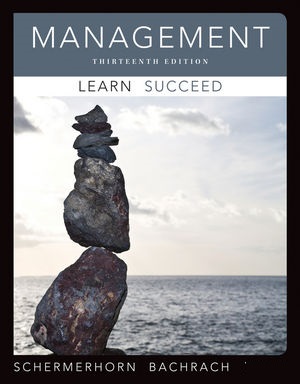
Management 13th Edition by John Schermerhorn,Daniel Bachrach
Edition 13ISBN: 978-1118841518
Management 13th Edition by John Schermerhorn,Daniel Bachrach
Edition 13ISBN: 978-1118841518 Exercise 28
THINK BEFORE YOU ACT
"There is no 'I' in team!" is a common cry. But basketball superstar Michael Jordan once responded: "There is an 'I' in win."
Creating Disharmony to Build a Better Team

"T here is no 'I' in team!" is a common cry. But basketball superstar Michael Jordan once responded: "There is an 'I' in win." What's the point here Jordan is suggesting that someone as expert in task direction as himself shouldn't always be subordinated to the team. Rather, the team's job may be to support his or her talents so that they shine to their brightest potential.
In his book, There Is an I in Team: What Elite Athletes and Coaches Really Know about High Performance (Harvard Business Review Press, 2012), Cambridge scholar Mark de Rond notes that sports metaphors abound in the workplace. We talk about "heavy hitters" and ask teammates to "step up to the plate." The real world of teamwork is dominated by the quest for cooperation, perhaps at the cost of needed friction. And that, according to du Rond, is a potential performance problem. "When teams work well," du Rond says, "it is because, not in spite, of individual differences."
Those in favor of du Rond's views are likely to argue that even if superstars bring a bit of conflict to the team, the result may well be added creativity and a performance boost. Instead of trying to make everyone happy, perhaps it's time for managers and team leaders to accept that disharmony can be functional, adding a needed edge. A bit of team tension may be a price worth paying for high performance. Those worried about du Rond's views might say there's a fine line between a superstar's real performance contribution and the collateral damage or negative impact caused by personality and temperament clashes. That line is a hard one to spot and to manage.
YOUR TAKE
Given what we know about teams and your personal experiences with them, should we be finding ways to accommodate superstars on a team... or avoid them
"There is no 'I' in team!" is a common cry. But basketball superstar Michael Jordan once responded: "There is an 'I' in win."
Creating Disharmony to Build a Better Team

"T here is no 'I' in team!" is a common cry. But basketball superstar Michael Jordan once responded: "There is an 'I' in win." What's the point here Jordan is suggesting that someone as expert in task direction as himself shouldn't always be subordinated to the team. Rather, the team's job may be to support his or her talents so that they shine to their brightest potential.
In his book, There Is an I in Team: What Elite Athletes and Coaches Really Know about High Performance (Harvard Business Review Press, 2012), Cambridge scholar Mark de Rond notes that sports metaphors abound in the workplace. We talk about "heavy hitters" and ask teammates to "step up to the plate." The real world of teamwork is dominated by the quest for cooperation, perhaps at the cost of needed friction. And that, according to du Rond, is a potential performance problem. "When teams work well," du Rond says, "it is because, not in spite, of individual differences."
Those in favor of du Rond's views are likely to argue that even if superstars bring a bit of conflict to the team, the result may well be added creativity and a performance boost. Instead of trying to make everyone happy, perhaps it's time for managers and team leaders to accept that disharmony can be functional, adding a needed edge. A bit of team tension may be a price worth paying for high performance. Those worried about du Rond's views might say there's a fine line between a superstar's real performance contribution and the collateral damage or negative impact caused by personality and temperament clashes. That line is a hard one to spot and to manage.
YOUR TAKE
Given what we know about teams and your personal experiences with them, should we be finding ways to accommodate superstars on a team... or avoid them
Explanation
In the present case it is given that the...
Management 13th Edition by John Schermerhorn,Daniel Bachrach
Why don’t you like this exercise?
Other Minimum 8 character and maximum 255 character
Character 255


